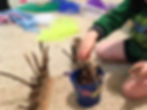Bringing Nature into the Preschool Classroom
Many years ago I attended a workshop with Richard Louv, author of “Last Child in the Woods.” He suggested that a starting place for getting children more in touch with nature is to bring a little nature into the classroom. Easily available and inexpensive natural materials can easily stand in for common early childhood manipulatives and art materials.
When I started on the nature school path, I had already been teaching young children for over 15 years. I had a stash of tried and true activities. My challenge to myself everyday was to think about how to replicate those successful activities using natural materials. For example, marble painting, where children place a sheet of paper on a rimmed tray and then gently guide a paint-laden marble to roll around the paper within the tray, is a common preschool art activity. To bring in a natural element, I replace the marbles with acorns. The following are activities and ideas that I hope will inspire you to bring more natural elements to your classrooms and children. My challenge to you is to find one way, starting tomorrow, that you can bring a little nature into your preschool program.
Using Natural Math Manipulatives
Math activities are easy to replicate using natural manipulatives. Rock, shell and leaf collections make inexpensive sorting, counting and patterning materials. We made our own Montessori style counting spindle boxes using numbered cardboard tubes mounted on a flat sheet of cardboard. The children read the number written on each tube and placed the corresponding number of objects in each tube. I introduced the activity using twigs I had gathered from my backyard as counters, since they are similar to the spindles used in the traditional Montessori version. However, any small natural item works.

Painting with Nature
The painting easel can also be transformed using natural materials. Whenever we find an inspiring natural object, we use it in place of a paintbrush. Pine needles, grass or flower buds can all be tied to the end of twigs to make brushes. Encouraging children to find their “brushes” gets them excited about the outdoors. The children experiment with dabbing or dragging to make different prints on paper. In fact, long-stemmed flowers can be used on their own without the extra step of “making” a paintbrush. We have also mixed seeds into our paint to create textured designs. Just be warned that seeds are meant to expand when exposed to moisture. If they are left in the paint, they will eventually suck it dry.

Nature on the Light Table
Another area of the indoor classroom that can easily incorporate natural materials is the light table. We have been known to put sand or salt directly on the light table and either use fingers or tools to draw designs. Letter and number stencils for tracing can transform the activity from art to math or literacy learning. In the winter, ice or snow goes in transparent tubs or trays on top of the light table for sensory exploration. In next month’s blog, I’ll go into depth about an Andy Goldsworthy study we did last year, but another fun idea for the light table is to use a mix of natural objects on the light table to make mandalas.
Natural Materials Inspire Imaginary Play
Real objects brought in from outdoors can be a part of what you are already doing in the blocks and dramatic play areas. Small logs make campfires or homes for stuffed animals and dolls. Skinny bamboo rods with crumpled white paper become perfect marshmallow roasters. Rocks get built into caves or double as cargo transported by toy trucks and trains. Companies now sell tree blocks and tree cookies specifically designed as preschool building toys, but scavenged objects get more use in our classroom.

A first step to bringing nature inside is just to provide interesting objects for children to explore. At Wildwood Nature School, we have studied things as exotic as birds’ nests, honeycombs, rib bones from elk and fossils, but simpler and easier to locate items work just as well. Unusually shaped gourds, chestnuts with or without the prickly outer shell, washed robin’s eggshells, feathers or driftwood paired with magnifying glasses, measuring tape, books, clipboards and pencils make an inviting investigation station. Once the children catch on to the value of these types of explorations, they will bring their own found “treasures” to add to the collection.


























